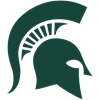For a live-updated bracket throughout the week check out our RotoWire Bracketology page.
We're a couple days away from Selection Sunday and this year, it looks like it will be happening. However, there are massive questions for the NCAA committee and how they'll select a bracket. Ideally, they won't put as much into predictive metrics because of the pandemic, but that means they won't use the NCAA's own stat, the NET (NCAA Evaluation Tool).
NET was created a couple years ago in the same season in which the committee decided they would no longer use RPI for deciding seeding in the NCAA tournament. Since there was no bracket last season, NET has only been used for the 2019 tournament, so there isn't a ton of data on how the committee will select teams with it. Adding the pandemic only makes things more difficult.
Per Kevin Pauga, creator of KPI, "In 2019, there were six teams that made the NCAA Tournament as at-large teams with a NET between 55 and 73.There were also six teams ranked between 33 and 48 in NET who did not make the tournament."
That at least points to the committee not blindly using NET and forgetting about everything else. While that could be the case again, there are a lot of teams in precarious spots because of good resumes but weak predictive metrics.
In prior seasons, quality of wins were used as a decider between power-conference teams, while strength of schedule and road record helped teams bump up a seed line. I'll use these theories to look at a few teams ahead of Selection Sunday.
I talked about the weird strength of schedules for some teams last week and since then, NET made a massive overhaul. A little more than a week ago, Michigan State had a SOS of 132, and that's now 6. St. Mary's had the No. 2 SOS in the country and that's now 60. Maybe we shouldn't use a stat that had to tinker its numbers less than two weeks ahead of Selection Sunday?
 Virginia (NET 13, KenPom 13, SOR 14). BracketMatrix 4. Once widely considered a 2-seed because of metrics, the Cavaliers don't have a ton of quality in their resume because of a down year for the ACC. They're 4-3 on the road in Q1, which is a stat the committee will likely focus on if they're pushed to a 3-seed. The Hoos are probably closer to a 5-seed, but in a shortened season, it's not easy to tell that and beating a bunch of mediocre teams could get them as high as a 3-seed.
Virginia (NET 13, KenPom 13, SOR 14). BracketMatrix 4. Once widely considered a 2-seed because of metrics, the Cavaliers don't have a ton of quality in their resume because of a down year for the ACC. They're 4-3 on the road in Q1, which is a stat the committee will likely focus on if they're pushed to a 3-seed. The Hoos are probably closer to a 5-seed, but in a shortened season, it's not easy to tell that and beating a bunch of mediocre teams could get them as high as a 3-seed.
 Oklahoma State (NET 29, KenPom 37, SOR 8). BracketMatrix 4. The Cowboys have had a late-season push, which is why their SOR is up to 10. Their metrics are lacking because a lot of those wins have been close. Similar to Virginia, they are 4-3 on the road in Q1 and maybe most importantly, are 8-5 overall in Q1 compared with 4-4 for Virginia. Given those numbers, it wouldn't be surprising if the committee overlooked metrics and bumped OK State over Virginia if they're fighting for a certain seed. If one of these teams is given a 3-seed in Selection Sunday, you'll know the committee took a specific direction with their seedings.
Oklahoma State (NET 29, KenPom 37, SOR 8). BracketMatrix 4. The Cowboys have had a late-season push, which is why their SOR is up to 10. Their metrics are lacking because a lot of those wins have been close. Similar to Virginia, they are 4-3 on the road in Q1 and maybe most importantly, are 8-5 overall in Q1 compared with 4-4 for Virginia. Given those numbers, it wouldn't be surprising if the committee overlooked metrics and bumped OK State over Virginia if they're fighting for a certain seed. If one of these teams is given a 3-seed in Selection Sunday, you'll know the committee took a specific direction with their seedings.
 Colorado (NET 12, KenPom 18, SOR 26). BracketMatrix 6. The Buffaloes can be considered a NET darling because their resume doesn't support them being ranked 13th. The outlying issue is three Q3 losses, two of them against the worst teams in the Pac-12. Combine that with a 2-4 Q1 road record and their NET doesn't make sense until you look at the score margins in their wins over USC. While I like the Buffs, I think they're a team who could be disappointed come Sunday unless they run through the Pac-12 tournament. They're projected as a 6-seed now, but if the committee avoids NET, a 7- or 8-seed is in play. If you're a Wisconsin fan, they're in a similar situation but with a worse resume.
Colorado (NET 12, KenPom 18, SOR 26). BracketMatrix 6. The Buffaloes can be considered a NET darling because their resume doesn't support them being ranked 13th. The outlying issue is three Q3 losses, two of them against the worst teams in the Pac-12. Combine that with a 2-4 Q1 road record and their NET doesn't make sense until you look at the score margins in their wins over USC. While I like the Buffs, I think they're a team who could be disappointed come Sunday unless they run through the Pac-12 tournament. They're projected as a 6-seed now, but if the committee avoids NET, a 7- or 8-seed is in play. If you're a Wisconsin fan, they're in a similar situation but with a worse resume.
 Missouri (NET 43, KenPom 50, SOR 23). BracketMatrix 6. Missouri will be one of the harder teams to figure out for the committee. The Tigers don't have a loss outside of the top tier of Q2, while also being 5-0 in the top tier of Q1. And yet, their predictive metrics place them outside of the top 40 because they were blown out a few times. They were given the last 4-seed when the NCAA revealed their top 16 a month ago and while they've lost five of seven, a run in the SEC tourney could see them jump to a 5-seed, if not higher.
Missouri (NET 43, KenPom 50, SOR 23). BracketMatrix 6. Missouri will be one of the harder teams to figure out for the committee. The Tigers don't have a loss outside of the top tier of Q2, while also being 5-0 in the top tier of Q1. And yet, their predictive metrics place them outside of the top 40 because they were blown out a few times. They were given the last 4-seed when the NCAA revealed their top 16 a month ago and while they've lost five of seven, a run in the SEC tourney could see them jump to a 5-seed, if not higher.
 Michigan State (NET 70, KenPom 56, SOR 37). BracketMatrix 11. The Spartans have been in this discussion almost all season, partly because I'm an alumnus and partly because the metrics hate them. As I've said before, if you remove a 30-point loss against Rutgers immediately following their COVID pause, they'd probably be 10 spots higher in most rankings, and if you look hard for it, you could say that for a lot of teams, which is where Strength of Record comes into play.
Michigan State (NET 70, KenPom 56, SOR 37). BracketMatrix 11. The Spartans have been in this discussion almost all season, partly because I'm an alumnus and partly because the metrics hate them. As I've said before, if you remove a 30-point loss against Rutgers immediately following their COVID pause, they'd probably be 10 spots higher in most rankings, and if you look hard for it, you could say that for a lot of teams, which is where Strength of Record comes into play.
For example, if you simply looked at results, how would you rate the below teams?
Team A: 17-10 overall, 4-10 Q1, 1-0 Q2
Team B: 16-8 overall, 4-7 Q1, 3-1 Q2
Team C: 15-12 overall, 5-11 Q1, 4-1 Q2
While it's never an end-all to look at records against the top two quadrants, it's still relevant to a point. One would guess that all of the teams are fairly even and probably fighting in the 8- or 9-seed range. They have some good wins, but they still have a losing record against the best ones. Team A is probably in the worst spot because of a losing record against the top two quadrants in addition to 12 of their 17 wins against what are considered to be bad teams.
Team A: Texas Tech (NET 16, KenPom 22, SOR 40). BracketMatrix 5.
Team B: LSU (NET 30, KenPom 30, SOR 30). BracketMatrix 8.
Team C: Michigan State (NET 70, KenPom 56, SOR 37). BracketMatrix 11.
Wait, what?
Yeah, that's how big of a factor metrics play in projecting tournament seeds. If metrics didn't exist and we looked at results only, Michigan State would probably be closer to a 6-seed than to the bubble, while Texas Tech would maybe be a 10-seed. The Red Raiders have a better record because 12 of their 17 wins are outside the top two quadrants (thanks Iowa State, Kansas State and TCU).
While I'm not hating on metrics, I just don't think they should be the focal point as much as prior seasons because being away from a basketball court for two weeks in the middle of the season has to be taken into account. The committee has a decision. Will they completely ignore that we're in a pandemic or will they put more into wins and losses (SOR) than previous seasons?
Metrics prior to games on Friday, Mar. 12.
For a live-updated bracket throughout the week check out our RotoWire Bracketology page.























